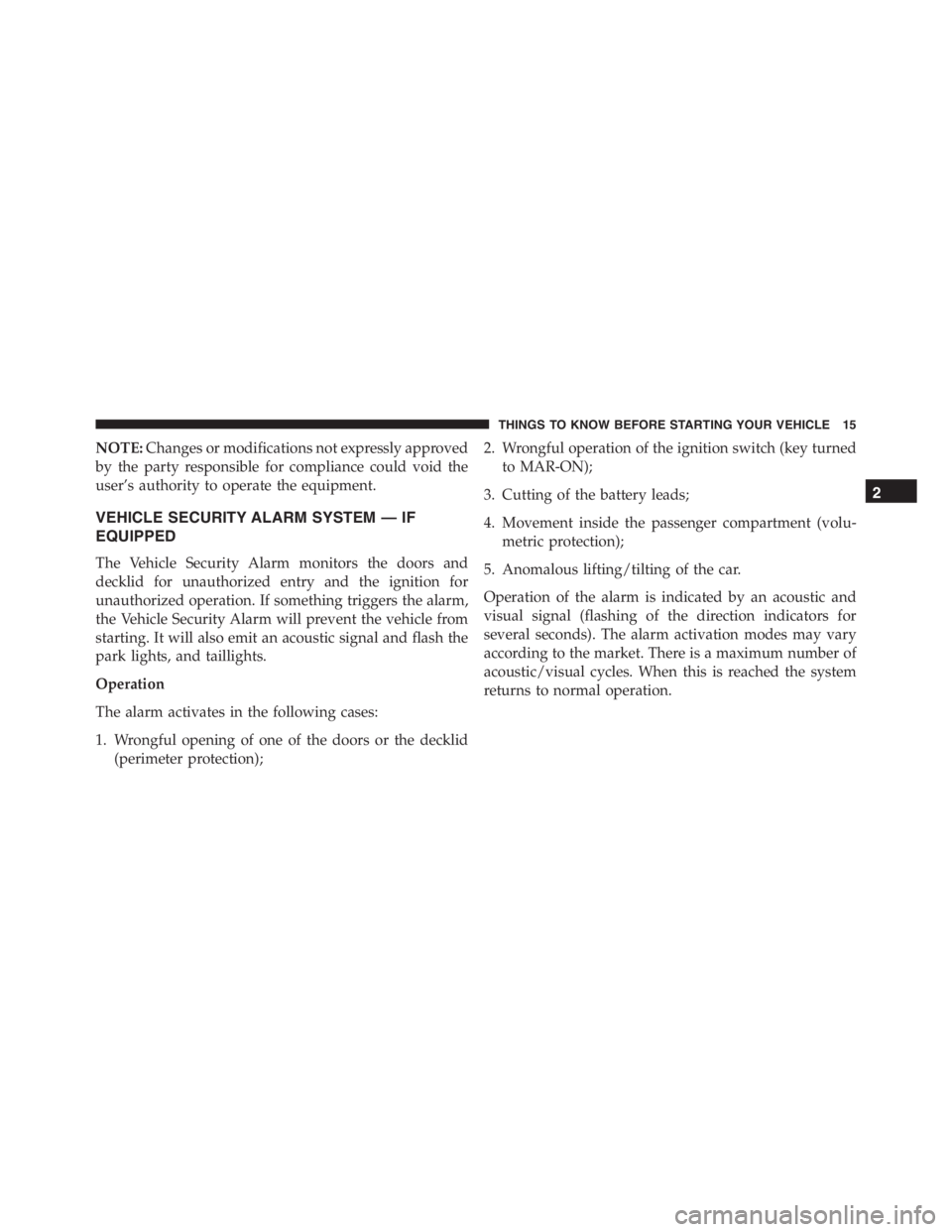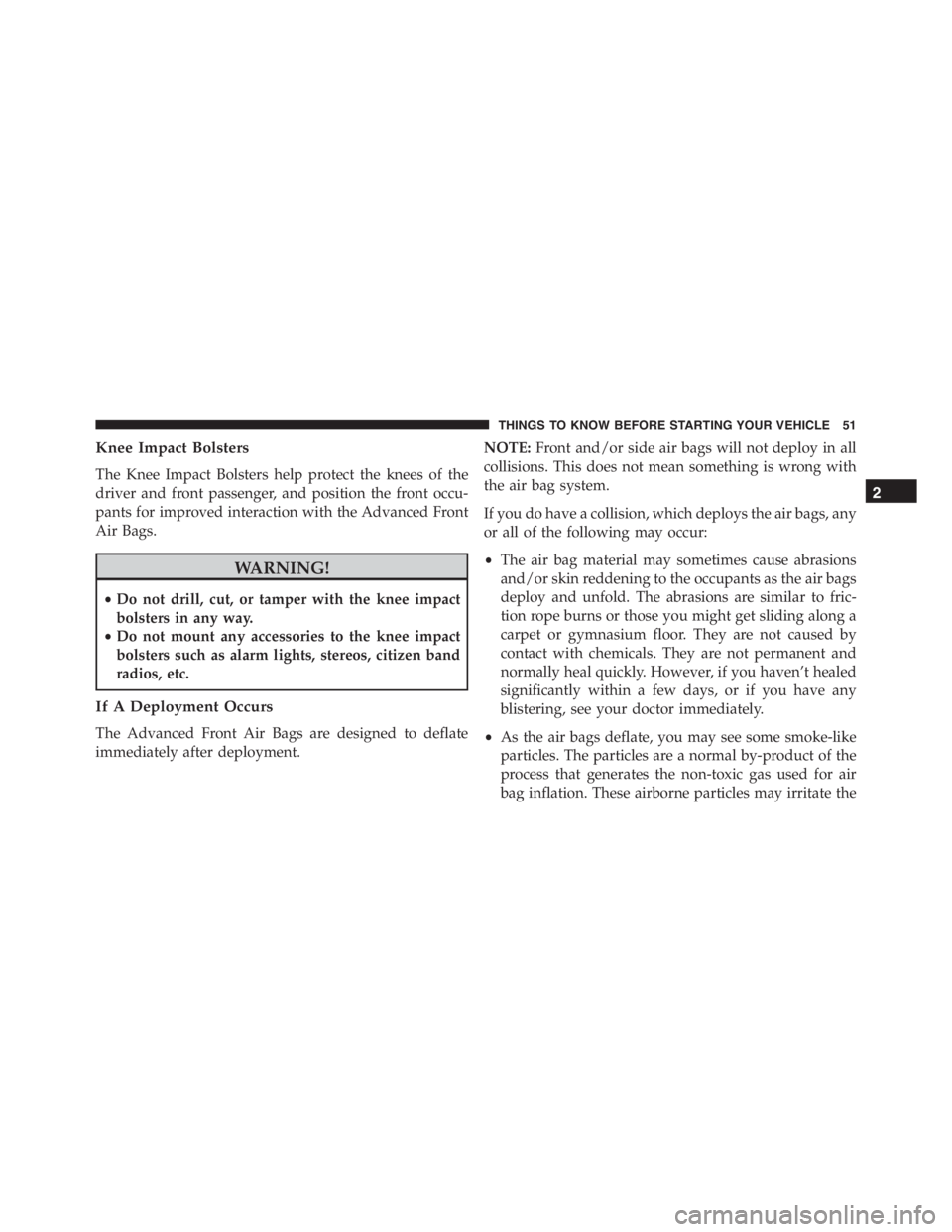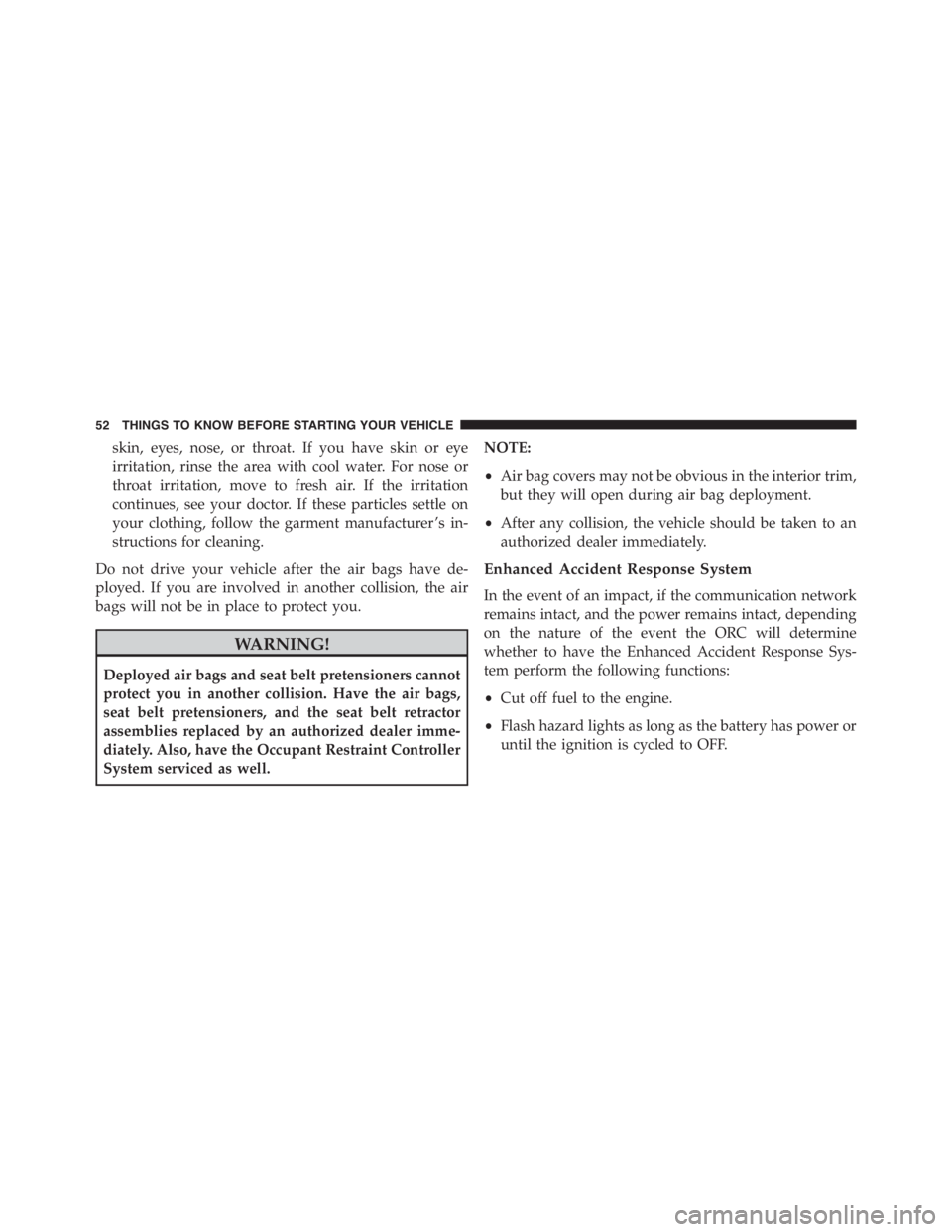Page 17 of 348

NOTE:Changes or modifications not expressly approved
by the party responsible for compliance could void the
user’s authority to operate the equipment.
VEHICLE SECURITY ALARM SYSTEM — IF
EQUIPPED
The Vehicle Security Alarm monitors the doors and
decklid for unauthorized entry and the ignition for
unauthorized operation. If something triggers the alarm,
the Vehicle Security Alarm will prevent the vehicle from
starting. It will also emit an acoustic signal and flash the
park lights, and taillights.
Operation
The alarm activates in the following cases:
1. Wrongful opening of one of the doors or the decklid
(perimeter protection);2. Wrongful operation of the ignition switch (key turned
to MAR-ON);
3. Cutting of the battery leads;
4. Movement inside the passenger compartment (volu-
metric protection);
5. Anomalous lifting/tilting of the car.
Operation of the alarm is indicated by an acoustic and
visual signal (flashing of the direction indicators for
several seconds). The alarm activation modes may vary
according to the market. There is a maximum number of
acoustic/visual cycles. When this is reached the system
returns to normal operation.
2
THINGS TO KNOW BEFORE STARTING YOUR VEHICLE 15
Page 20 of 348

If a perimeter violation triggers the security system, the
siren will sound for 30 seconds and the exterior lights
will flash followed by approximately five seconds of no
activity. This will continue for eight cycles if no action is
taken to disarm the system.
The alarm takes approximately 20 seconds to arm once
the doors are locked with the key fob and once armed,
the LED indicator on the dash will blink whenever the
system is armed. If motion is detected during the arming
period, the motion detection system is disabled.
To ensure the correct operation of the protection, com-
pletely close the side windows. If a perimeter violation
triggers the security system, the siren will sound and the
exterior lights will flash.
To disable the volumetric protection, turn the ignition
key from STOP to MAR-ON twice in a row, then activate
the alarm within 15 seconds, pushing the lock button onthe remote control. When the function is deactivated, this
is indicated by the vehicle security light in the instrument
panel flashing for several seconds.
To disable the anti-lift protection, the ignition key must
be turned from STOP to MAR-ON three times in a row,
followed by activating the alarm within 15 seconds,
pushing the lock button on the remote control.
When the function is deactivated, this is indicated by the
vehicle security light in the instrument panel flashing for
several seconds.
Any disabling of the volumetric/anti-lift protection must
be repeated each time the instrument panel is switched
off.
18 THINGS TO KNOW BEFORE STARTING YOUR VEHICLE
Page 21 of 348

ILLUMINATED ENTRY
The interior lights will turn on whenever a door is
opened and the dimmer switch is not in the defeat
position.
The interior lights will turn on, remain on for approxi-
mately 30 seconds, and then fade to off if a door is
opened using the outside door handle and then closed or
a door is unlocked using the vehicles key.
The interior lights will turn on and remain on for about
four seconds and then fade to off if a door is opened
using the inside door handle.
NOTE:None of the courtesy lights will operate if the
dimmer control is in the “defeat” position (extreme
downward position), unless the overhead map/reading
lights are turned on manually.
REMOTE KEYLESS ENTRY (RKE) — IF
EQUIPPED
This system allows you to lock or unlock the doors and
decklid from distances up to approximately 66 ft (20 m)
using a hand-held Remote Keyless Entry (RKE) transmit-
ter. The RKE transmitter does not need to be pointed at
the vehicle to activate the system.2
THINGS TO KNOW BEFORE STARTING YOUR VEHICLE 19
Page 22 of 348
NOTE:The line of transmission must not be blocked
with metal objects.
To Unlock The Doors
Push and release the UNLOCK button on the RKE
transmitter to unlock the doors. The park lights and turn
signal lights will flash to acknowledge the signal and the
illuminated entry system will turn on.
NOTE:The Door Unlock Indicator will illuminate in the
instrument panel when one or both doors are unlocked.
To Lock The Doors
Push and release the LOCK button on the RKE transmit-
ter: locking of doors, switching off of internal roof light
and single flashing of direction indicators.
If one or more door are open, the doors will not be
locked. This is indicated by a rapid flashing of the
direction indicators. The doors will be locked if the
decklid is open however.
When a speed of more than 12 mph (20 km/h) is reached,
the doors will be locked automatically if the Autoclose
Key Fob
1 — Vehicle Key
2 — Push To Open/Close Vehicle Key 20 THINGS TO KNOW BEFORE STARTING YOUR VEHICLE
Page 53 of 348

Knee Impact Bolsters
The Knee Impact Bolsters help protect the knees of the
driver and front passenger, and position the front occu-
pants for improved interaction with the Advanced Front
Air Bags.
WARNING!
•Do not drill, cut, or tamper with the knee impact
bolsters in any way.
•Do not mount any accessories to the knee impact
bolsters such as alarm lights, stereos, citizen band
radios, etc.
If A Deployment Occurs
The Advanced Front Air Bags are designed to deflate
immediately after deployment.NOTE:Front and/or side air bags will not deploy in all
collisions. This does not mean something is wrong with
the air bag system.
If you do have a collision, which deploys the air bags, any
or all of the following may occur:
•The air bag material may sometimes cause abrasions
and/or skin reddening to the occupants as the air bags
deploy and unfold. The abrasions are similar to fric-
tion rope burns or those you might get sliding along a
carpet or gymnasium floor. They are not caused by
contact with chemicals. They are not permanent and
normally heal quickly. However, if you haven’t healed
significantly within a few days, or if you have any
blistering, see your doctor immediately.
•As the air bags deflate, you may see some smoke-like
particles. The particles are a normal by-product of the
process that generates the non-toxic gas used for air
bag inflation. These airborne particles may irritate the
2
THINGS TO KNOW BEFORE STARTING YOUR VEHICLE 51
Page 54 of 348

skin, eyes, nose, or throat. If you have skin or eye
irritation, rinse the area with cool water. For nose or
throat irritation, move to fresh air. If the irritation
continues, see your doctor. If these particles settle on
your clothing, follow the garment manufacturer ’s in-
structions for cleaning.
Do not drive your vehicle after the air bags have de-
ployed. If you are involved in another collision, the air
bags will not be in place to protect you.
WARNING!
Deployed air bags and seat belt pretensioners cannot
protect you in another collision. Have the air bags,
seat belt pretensioners, and the seat belt retractor
assemblies replaced by an authorized dealer imme-
diately. Also, have the Occupant Restraint Controller
System serviced as well.NOTE:
•Air bag covers may not be obvious in the interior trim,
but they will open during air bag deployment.
•After any collision, the vehicle should be taken to an
authorized dealer immediately.
Enhanced Accident Response System
In the event of an impact, if the communication network
remains intact, and the power remains intact, depending
on the nature of the event the ORC will determine
whether to have the Enhanced Accident Response Sys-
tem perform the following functions:
•Cut off fuel to the engine.
•Flash hazard lights as long as the battery has power or
until the ignition is cycled to OFF.
52 THINGS TO KNOW BEFORE STARTING YOUR VEHICLE
Page 55 of 348
•Turn on the interior lights, which remain on as long as
the battery has power or until the ignition is cycled to
OFF.
•Unlock the doors automatically.
System Reset Procedure
Depending on the nature of the event the left and right
turn signal lights, located in the instrument panel, may
both be blinking and will continue to blink until the
ignition switch is turned to the OFF position. In order to
move your vehicle to the side of the road, you must
follow the system reset procedure.Customer Action Customer Will See
1. Turn ignition OFF.
(Turn Signal Switch Must
be placed in Neutral
State).
2. Turn ignition ON. Left Turn Light is OFF.
Right Turn Light
BLINKS.
3. Turn Right Turn Signal
Switch ON.Right Turn Light is ON
SOLID. Left Turn Light
BLINKS.
4. Turn Left Turn Signal
Switch ON.Left Turn Light is ON
SOLID. Right Turn Light
BLINKS.
5. Turn Right Turn Signal
Switch ON.Right Turn Light is ON
SOLID. Left Turn Light
BLINKS.
2
THINGS TO KNOW BEFORE STARTING YOUR VEHICLE 53
Page 56 of 348

6. Turn Left Turn Signal
Switch ON.Left Turn Light is ON
SOLID. Right Turn Light
is ON SOLID.
7. Turn Left Turn Signal
Switch OFF. (Turn Signal
Switch Must be placed in
Neutral State).Left Turn Light is OFF.
Right Turn Light is OFF.
8. Turn ignition OFF. System is now reset and
the engine may be
started.
9. Turn Hazard Flashers
OFF (Manually).
If a reset procedure step is not completed within 45
seconds, then the turn signal lights will turn off and the
reset procedure must be performed again in order to be
successful.Air Bag Warning Light
The air bags must be ready to inflate for your protection
in a collision. The Air Bag Warning Light
monitors the internal circuits and interconnect-
ing wiring associated with air bag system elec-
trical components.
The ORC monitors the readiness of the electronic parts of
the air bag system whenever the ignition switch is in the
START or ON/RUN position. If the ignition switch is in
the OFF position the air bag system is not on and the air
bags will not inflate.
The ORC contains a backup power supply system that
may deploy the air bags even if the battery loses power or
it becomes disconnected prior to deployment.
Also, the ORC turns on the Air Bag Warning Light in the
instrument panel for approximately four to eight seconds
for a self-check when the ignition is first turned to the
54 THINGS TO KNOW BEFORE STARTING YOUR VEHICLE